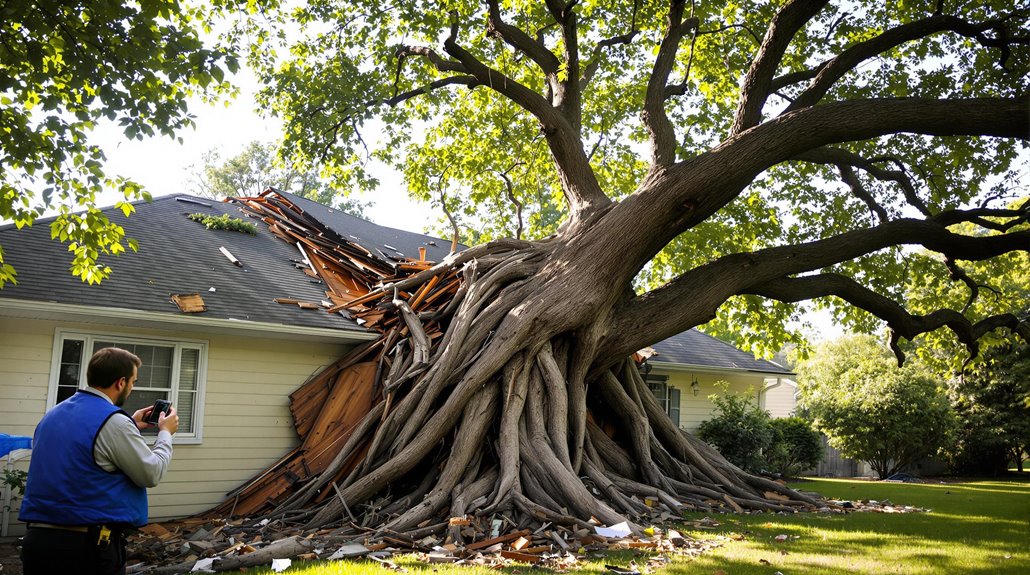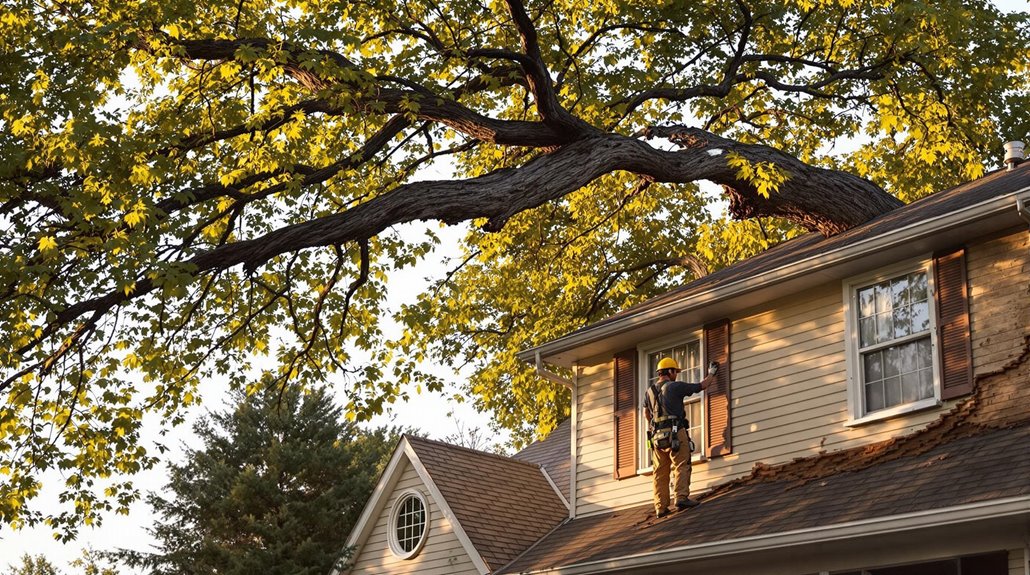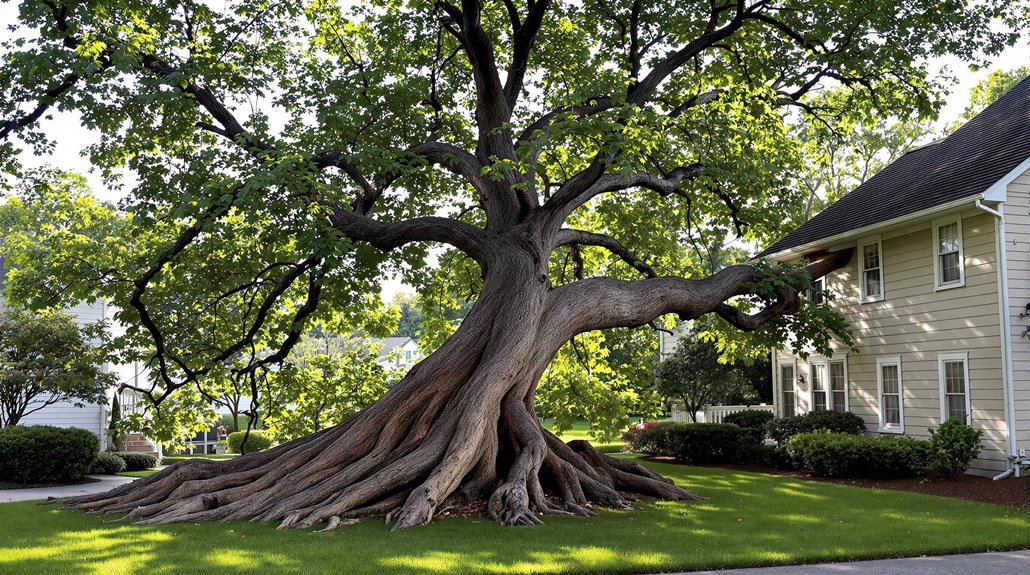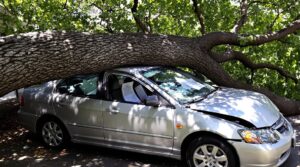Home insurance typically covers tree removal when a fallen tree damages insured structures like homes or garages due to covered perils such as storms. Standard policies include debris removal coverage ranging from $500 to $1,000. Insurance also covers trees blocking essential access points like driveways or ramps. However, trees that fall without damaging structures are generally not covered. Several factors determine coverage eligibility and claim success in tree-related incidents.
Key Takeaways
- Home insurance covers tree removal when a fallen tree damages insured structures like homes or garages due to natural causes.
- Standard policies typically provide $500-$1,000 for debris removal costs after covered incidents.
- Insurance covers fallen trees blocking essential access points like driveways, even without structural damage.
- Trees falling in yards without damaging insured structures are generally not covered by home insurance.
- Coverage applies regardless of tree ownership, including neighbor's trees, as long as damage occurs to insured structures.
Understanding Tree Removal Coverage in Home Insurance
When homeowners face fallen trees on their property, understanding the specifics of their insurance coverage becomes critical for managing removal costs.
Home insurance typically covers tree removal when the tree falls due to natural causes such as storms, wind, lightning, or ice accumulation, but only if it damages an insured structure like a home, garage, or fence.
Insurance providers generally limit debris removal coverage to between $500 and $1,000, regardless of tree species or size. Coverage may extend to trees blocking driveways or disability access ramps.
However, policies exclude removal costs for trees that fall without damaging insured structures or those that fall due to negligence in maintenance routine. Trees that fall from rot, age, or poor maintenance are not covered, as these situations are considered preventable.
Additionally, standard policies exclude coverage for trees that fall during events not covered by the policy, such as floods or earthquakes.
When Your Insurance Will Pay for Tree Removal

Your home insurance will cover tree removal costs in specific scenarios that align with policy terms and covered perils.
When trees fall due to storms, wind, lightning, or other covered events and damage insured structures, insurance providers typically cover both the property damage and tree removal expenses. Coverage extends to various structures specified in the policy, including homes, garages, sheds, and fences.
- Tree damage from covered perils like storms, with removal costs usually capped between $500-$1,000
- Fallen trees blocking essential access points such as driveways or handicapped ramps
- Cases involving neighbor liability where poor tree health led to property damage
- Trees that damage insured structures, regardless of the tree's origin
Insurance companies consider multiple factors when processing tree removal claims.
While a neighbor's tree falling onto your property is covered by your insurance, providers may seek reimbursement from neighbors if negligence in tree maintenance is proven. Homeowners should evaluate their deductibles against removal costs before filing claims.
Key Exclusions and Non-Covered Scenarios

Standard homeowners insurance policies consistently exclude numerous scenarios related to tree removal, particularly those involving preventative maintenance or trees that fall without damaging insured structures. Regular tree maintenance, including the removal of diseased or dying trees, is considered routine upkeep and falls outside policy coverage. Policy differences exist among insurers, but most maintain strict exclusions for preventative removal.
| Scenario | Typically Covered | Typically Excluded |
|---|---|---|
| Tree hits house | Yes | No |
| Tree falls in yard | No | Yes |
| Preventative removal | No | Yes |
Coverage limitations extend beyond basic maintenance scenarios. Insurance policies generally won't cover removal costs for trees that fall due to natural wear, floods, or earthquakes unless specific endorsements are added. Even when trees fall during storms, removal is typically only covered if the tree damages an insured structure. Most policies cap debris removal reimbursement between $500 and $1,000, making it essential to understand these coverage limitations.
Cost Factors That Affect Tree Removal Claims

The size and location of fallen trees greatly influence insurance claim costs, with larger trees and those near structures requiring specialized equipment and careful removal procedures.
Labor costs escalate when trees are in difficult-to-access areas or when emergency removal services are needed, particularly after storms or natural disasters.
Insurance policies typically limit coverage for tree removal to between $500 and $1,000, regardless of the actual removal costs, which can reach several thousand dollars for complex situations.
Size and Location Influence
Size and location represent two primary factors that greatly influence tree removal costs and related insurance claims. Tree height greatly impacts costs, with removal ranging from $150 for shorter trees up to $2,000 for those exceeding 80 feet.
Location importance becomes evident when trees are situated near buildings or power lines, requiring specialized equipment and expertise that can considerably increase removal expenses.
- Trees near structures typically demand more complex removal procedures and higher insurance coverage
- Power line proximity necessitates additional safety measures and specialized equipment
- Height categories directly correlate with removal costs: taller trees require cranes and extra personnel
- Location accessibility affects both removal complexity and potential insurance claim coverage
Equipment and Labor Costs
Professional tree removal operations require substantial equipment and labor investments that greatly impact insurance claims and overall costs.
Equipment considerations include specialized machinery like cranes for tall trees, aerial lifts for difficult access points, and essential tools such as chainsaws and stump grinders. Safety equipment and protective gear for workers are also necessary expenditures.
Labor complexities greatly affect removal costs, with skilled arborists and larger crews required for challenging projects. The time needed for removal, expertise level required, and additional services like stump removal all factor into labor expenses.
When trees are located near structures or power lines, extra precautions and specialized techniques are needed, further increasing both equipment and labor requirements.
Emergency situations and after-hours work typically command premium rates due to increased risk and urgency.
Insurance Coverage Limits
Understanding insurance coverage limits for tree removal requires careful consideration of multiple cost factors that affect claims.
Standard policies typically provide coverage ranging from $500 to $1,000 when trees damage insured structures due to covered perils like storms or ice. The claim process involves evaluating whether the tree fell due to a covered event rather than negligence or poor maintenance.
- Coverage extends to removal costs if trees block essential access points like driveways or wheelchair ramps.
- Trees falling without damaging insured structures generally aren't covered under standard policy updates.
- Neighboring property damage scenarios require clear documentation and communication between parties.
- Preventive tree removal and maintenance costs are excluded from typical home insurance coverage.
Essential Steps to File a Tree Removal Claim

Filing a successful tree removal claim requires gathering thorough documentation of the incident and resulting damage.
Property owners should immediately photograph the fallen tree, damaged structures, and surrounding area while collecting relevant receipts, witness statements, and professional assessments.
Prompt notification to the insurance provider, along with submission of this evidence, helps guarantee proper claim processing and ideal coverage for tree removal and associated repairs.
Document Required Evidence
When submitting a tree removal insurance claim, proper documentation serves as the foundation for a successful filing process. Documenting incidents thoroughly and preserving evidence requires systematic attention to detail, including precise recording of dates, times, and damage extent. Insurance adjusters rely on extensive documentation to evaluate claims accurately.
- Capture multiple photographs showing damage from various angles and distances.
- Maintain a chronological log of all communications with adjusters and contractors.
- Collect professional assessment reports and estimates for removal services.
- Gather any pre-incident documentation showing the tree's condition before damage.
This evidence forms an essential package that supports the claim's validity. A well-documented case includes detailed descriptions of the incident, photographs of all damage, professional evaluations, and a clear timeline of events, greatly improving the likelihood of claim approval.
Contact Insurance Right Away
Promptness in reporting tree damage to insurance providers plays a crucial role in successful claim processing. The immediate action of contacting insurance companies guarantees proper documentation and timely assessment of the situation. Property owners should provide detailed descriptions of the damage along with photographic evidence during this initial contact.
Understanding the claim importance, insurance companies will dispatch adjusters to evaluate the extent of damage either through an in-person visit or by reviewing submitted photographs. During this process, insurers verify coverage under the policy and may request itemized invoices from tree removal services.
To facilitate a smooth claims process, homeowners should select reputable tree removal services experienced in handling insurance claims, as these companies can provide the necessary documentation and may offer direct billing to insurance carriers.
Preventive Measures to Lower Tree Damage Risk

Taking proactive steps to prevent tree damage is essential for homeowners seeking to protect their property and maintain their insurance coverage.
Regular tree inspection and proper pruning techniques form the foundation of effective preventive maintenance. Professional arborists can identify potential hazards, such as dead branches, trunk cracks, or leaning trees, before they become serious problems during storms.
- Annual pruning to remove dead, diseased, or damaged branches
- Installation of bracing and cabling systems for structural support
- Implementation of disease and pest management protocols
- Regular mulching to maintain tree health and root stability
Structural support measures, such as steel cables between trunk limbs, can greatly improve a tree's ability to withstand severe weather conditions.
Additionally, maintaining tree health through proper disease and pest management increases resilience to storm damage.
These preventive measures, when implemented under professional guidance, can markedly reduce the risk of tree-related property damage and subsequent insurance claims.
Special Coverage Options for Tree-Related Incidents

Understanding the limitations of standard home insurance policies leads many homeowners to explore specialized coverage options for tree-related incidents.
Insurance endorsements can expand protection beyond basic coverage limits, particularly for scenarios not typically included in standard policies.
Homeowners can purchase additional coverage to increase the standard debris removal limit beyond the typical $500-$1,000 cap.
Special endorsements may also provide coverage for events like floods or earthquakes that normally exclude tree damage.
For properties with valuable landscaping, expanded coverage up to 5% of the home's insured value can protect against losses.
Some insurers offer supplemental coverage specifically focused on tree health and preventive care.
These policies may cover professional arborist services, disease treatment, and removal of hazardous trees before they cause damage.
While these additional coverages increase premium costs, they provide thorough protection against tree-related risks that standard policies exclude.
Making Informed Decisions About Tree Insurance Coverage

When making decisions about tree insurance coverage, homeowners must carefully evaluate their property's specific risks and existing policy limitations. Understanding the extent of coverage for tree-related incidents enables property owners to make informed choices about additional protection needs and maintenance strategies.
- Insurance policies typically cover tree removal only when storms or other covered perils cause damage to insured structures.
- Most standard policies limit debris removal coverage to $500-$1,000, which may not cover full removal costs.
- Regular maintenance and professional tree assessments can help prevent claim denials due to neglect.
- Trees located near structures present higher risk factors that warrant careful policy review.
Homeowners should assess their tree risk by considering factors such as tree health, proximity to structures, and local weather patterns. This evaluation, combined with a thorough understanding of policy coverage limitations, helps determine whether additional insurance endorsements or proactive tree maintenance would better serve their needs.
Frequently Asked Questions
Will Insurance Cover Tree Removal if My Neighbor's Tree Falls on My Property?
Homeowners insurance typically covers tree removal costs when a neighbor's tree damages insured structures. While initial coverage comes from the policyholder's insurance, subrogation may later determine neighbor's responsibility for damages.
How Does Lightning Damage to Trees Affect My Insurance Coverage Limits?
Insurance policies typically cover tree removal if a lightning strike damages insured structures, with coverage limits usually between $500-$1,000 for debris removal and 5% of dwelling coverage for landscaping damage.
Can I Add Extra Coverage Specifically for Tree Removal to My Policy?
With tree removal costs averaging $1,200 per incident, homeowners can secure additional tree coverage through policy endorsements and riders that extend standard policy limits for enhanced protection.
Does Insurance Cover Tree Removal if Roots Damage My Foundation?
Homeowners insurance typically covers foundation repair caused by tree root damage. Coverage extends to both the property owner's trees and neighboring trees that affect the home's structural integrity.
Will My Rates Increase if I File a Claim for Tree Removal?
Persistent premium patterns show that filing tree removal claims may prompt rate increases. Insurance providers evaluate claims history and cost factors when determining potential adjustments to homeowner policy rates.
Final Thoughts
Tree removal coverage resembles a safety net with strategic holes – it catches major storm-related damages while letting routine maintenance fall through. Like traversing through a forest, understanding one's policy requires careful attention to detail. Homeowners who cultivate knowledge about their coverage limits, maintain proper documentation, and implement preventive measures stand the strongest chance of weathering tree-related challenges successfully.
For homeowners dealing with tree-related property damage claims under their homeowners insurance policy, insurance industry professionals and legal experts strongly advise consulting a qualified state-licensed public adjuster. These professionals work exclusively for policyholders, not insurance companies, serving as dedicated advocates throughout the claims process. Public adjusters are specifically trained to identify hidden damages often overlooked by policyholders and unknown covered losses within their policies. They meticulously document damages, assess losses, and negotiate with insurance companies to ensure fair settlements while protecting policyholders' legal rights.
Engaging a public adjuster can lead to higher claim settlements, expedited processing, and reduced stress during the claims process, allowing homeowners to focus on property restoration. Policyholders interested in discussing their tree damage claims can request a no-obligation free consultation with a Public Claims Adjusters Network (PCAN) member public adjuster through their contact page.








